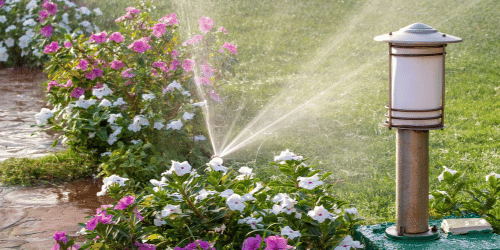A well-designed irrigation system is crucial for maintaining a healthy and vibrant landscape. One of the key components of any irrigation setup is selecting the right sprinkler heads. In this blog post, we’ll explore the factors to consider when choosing sprinkler heads, ensuring efficient water distribution and optimal plant health.
Choosing the appropriate sprinkler heads involves assessing water pressure, understanding your landscape’s needs, and considering factors like soil type and climate.
Types of Sprinkler Heads
Rotary Sprinkler Heads
Ideal for large areas with consistent water pressure, rotating streams cover a wide radius. These sprinklers are suitable for lawns, sports fields, and parks, providing efficient irrigation over extensive spaces. Their design ensures even water distribution, promoting healthy, lush grass and vegetation. The rotating action helps prevent water waste by targeting specific areas accurately. By using these sprinklers, you can maintain large green spaces effectively, ensuring they receive the consistent watering needed to thrive.
Spray Sprinkler Heads
Fixed spray patterns with adjustable nozzles are best for smaller areas and precise watering. These sprinklers are commonly used in flower beds and shrubbery, where targeted irrigation is crucial. Adjustable nozzles allow for customization of the spray pattern and reach, ensuring that water is applied exactly where it’s needed. This prevents overwatering and promotes the health of plants. Fixed spray sprinklers are an excellent choice for maintaining smaller garden areas with accuracy and efficiency.
Drip Irrigation
Delivers water directly to the root zone, making it efficient for conserving water and preventing overspray. This method is perfect for garden beds and individual plants, ensuring that water is precisely applied where it’s most needed. By targeting the root zone, this irrigation technique promotes healthier plant growth and reduces water waste. Ideal for maintaining optimal moisture levels in specific areas, it helps create a thriving garden environment.
Factors to Consider
Water Pressure and Flow
Each sprinkler head type has specific pressure requirements. Measure available PSI (pounds per square inch) to choose compatible heads. Ensuring the correct pressure compatibility is crucial for optimal sprinkler performance and water distribution. Using sprinkler heads that match your system’s PSI prevents inefficiencies and potential damage. By selecting the right sprinkler heads based on pressure measurements, you can maintain an efficient and effective irrigation system.
Climate Considerations
Windy areas: Opt for low-angle nozzles to prevent water drift. This ensures that water reaches the intended areas without being blown away. Arid climates: Use higher flow nozzles or multiple cycles to combat heat stress. This approach helps provide sufficient water to plants and lawns, preventing them from drying out in hot conditions. Adjusting nozzle types based on environmental conditions ensures effective irrigation and water conservation.
Soil Type and Terrain
Adjust application rate to match soil intake. Low precipitation rate (PR) nozzles prevent runoff on slopes, ensuring that water is absorbed efficiently without causing erosion or waste. Matching the application rate to the soil’s absorption capacity helps maintain healthy plant growth and soil integrity. This is especially important on slopes where water can easily run off before being absorbed. Using low PR nozzles in such areas provides more effective and sustainable irrigation.
Area Coverage and Plant Material
Size and Shape of Areas
Select sprinkler heads that cover the area efficiently. Minimize the number of units while ensuring proper coverage. This approach helps reduce costs and simplifies maintenance, while still providing adequate irrigation for your lawn or garden. By strategically placing fewer sprinkler heads to maximize coverage, you ensure that all areas receive the necessary water without overlapping or gaps. Efficient selection and placement of sprinkler heads contribute to an optimal and cost-effective irrigation system.
Types of Plant Material
Lawns, shrubs, trees, and ground covers have varying water needs. Tailor sprinkler heads accordingly for each plant type to ensure they receive the appropriate amount of water. Lawns generally require even coverage with moderate water, while shrubs and ground covers may need more targeted watering. Trees often need deeper, less frequent watering to reach their roots. Using the right sprinkler heads for each plant type helps promote healthy growth and efficient water use, ensuring that every part of your landscape gets the care it needs.
Protection of Hardscapes
Avoid overspray onto structures that can’t tolerate water exposure. This prevents potential damage to buildings, fences, and pathways that could be harmed by constant moisture. Proper sprinkler placement and adjustment ensure water is directed only to plants and lawn areas, maximizing efficiency and protecting your property. By preventing overspray, you also conserve water and reduce waste, contributing to a more sustainable irrigation system.
Sprinkler Head Maintenance
Regular Inspection
Check for clogs: Remove and clean nozzles to prevent blockages. This ensures that water flows freely and evenly through the system. Inspect seals and O-rings: Replace damaged seals to maintain proper water flow and prevent leaks. Regularly check these components to ensure they are in good condition. Lubricate moving parts: Ensure smooth rotation for rotary heads by applying appropriate lubrication. This helps maintain the efficiency and longevity of your sprinkler system, ensuring it operates effectively throughout the watering season.
Adjustments and Repairs
Fine-Tuning Nozzles: Modify spray patterns as needed to achieve optimal coverage and water distribution. Adjusting the angle and flow rate of the nozzles ensures that water reaches all areas of your landscape efficiently. Replace Broken Heads: Promptly fix damaged or malfunctioning sprinkler heads to prevent water waste and maintain uniform irrigation. Regularly inspect and replace broken heads to keep your system running smoothly. Realign Misaligned Heads: Ensure even coverage across the landscape by realigning misaligned sprinkler heads. Proper alignment prevents dry spots and overwatering, promoting healthy plant growth and conserving water resources.
Winterization
Drain and Store: Before freezing temperatures, remove and store sprinkler heads indoors to prevent damage from ice formation. Storing them in a climate-controlled environment ensures they remain in good condition for the next watering season. Blow Out Lines: Use compressed air to clear water from the system to prevent freezing and damage to pipes and components. This process removes any remaining water from the system, reducing the risk of costly repairs due to winter damage. Regular maintenance before winter ensures that your sprinkler system remains functional and ready for use when warmer weather returns.
Answering Common Questions
Q1How do I determine the right sprinkler head spacing?
A1 Proper spacing depends on the type of sprinkler head and the area’s dimensions. Consult manufacturer guidelines for specific recommendations.
Q2 Can I mix different sprinkler head types on the same valve?
A2 It’s best to avoid mixing components with different precipitation rates on the same valve. Separate valves ensure uniform water application.
Q3 What if my water pressure fluctuates?
A3 Consider pressure-regulating heads or install a pressure regulator to maintain consistent performance.
The Impact of Water Conservation
Efficient sprinkler head selection contributes to water conservation efforts. By choosing the right heads, you reduce wastage and promote sustainable irrigation practices.
Seeking Expert Advice
For customized recommendations based on your specific landscape, consult a professional irrigation specialist. They can assess your site, calculate water requirements, and design an efficient system tailored to your needs.
Conclusion Choosing The Right Sprinkler Heads for Your Irrigation System
Selecting the appropriate sprinkler heads is a critical step in creating an efficient irrigation system. By considering factors like water pressure, climate, soil type, and area coverage, you can optimize water distribution and promote healthy plant growth.
Understand the size, shape, and specific watering needs of your lawn, garden, or green space. Whether it’s rotary heads for large areas or drip irrigation for precise watering, select the right type based on your requirements. Inspect, adjust, and repair sprinkler heads to ensure consistent performance. A well-designed irrigation system not only conserves water but also enhances the beauty of your outdoor space.
Visit Us At Tailor Made
For more information and personalized guidance, visit us at Tailor Made Contracting is here to provide you with exceptional landscape design services that transform your outdoor space into a work of art. Whether you’re dreaming of a lush garden, a tranquil patio, or a vibrant play area, we’ll bring your vision to life. Contact us today and let’s create something extraordinary together!







